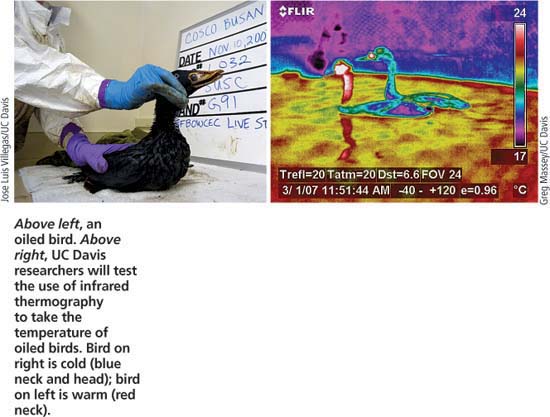All Issues
Oiled birds cleaned up and sent home; research studies launched
Publication Information
California Agriculture 62(1):7-8.
Published January 01, 2008
PDF | Citation | Permissions
Full text
The 58,000–gallon oil spill in San Francisco Bay on Nov. 7, 2007, was the worst in a decade, and weeks later rescuers were still collecting coated birds from beaches. The oiled birds — primarily grebes, scaups and surf scoters — were brought to the Cordelia facility of the Oiled Wildlife Care Network, which comprises 25 organizations and a dozen facilities from Crescent City to San Diego, and is directed by UC Davis wildlife veterinarian Michael Ziccardi.
After the November 2007 oil spill in the San Francisco Bay, staff and volunteers with the Oiled Wildlife Care Network washed about 800 oiled birds at their Cordelia facility.
Saving oiled birds is far from a sure thing. “They arrive cold and weak because oil coats their feathers, forcing them to come out of the water to survive,” Ziccardi says. Many die before they can even be cleaned, and more die in the rehabilitation pools prior to release. By the end of November, more than a thousand birds had been collected, nearly 800 had been washed, and more than 340 had been rehabilitated and released in Tomales and Half Moon bays, which lie beyond the reach of the oil spill. Nearly 1,750 birds were collected dead, and about 600 died or were euthanized in captivity.
The Cordelia center — called the San Francisco Bay Oiled Wildlife Care and Education Center — is a 12,000–square-foot, $2.7 million facility capable of caring for between 1,000 and 1,500 sick birds, and is co-managed by the International Bird Rescue Center. The Oiled Wildlife Care Network is funded by the California Department of Fish and Game, with interest on the $50 million California Oil Spill Response Trust Fund built from assessments on the oil industry.
Studies aimed at survival of oiled birds
Little is known about what happens to the relatively few birds lucky enough to make it back to the wild, but Ziccardi and his colleagues are trying to find out. The veterinarians are implanting about 25 oiled and rehabilitated birds and an equal number of control birds with tiny backpack-style radio transmitters so their whereabouts and survival can be tracked.
Above left, an oiled bird. Above right, UC Davis researchers will test the use of infrared thermography to take the temperature of oiled birds. Bird on right is cold (blue neck and head); bird on left is warm (red neck).
The team is also launching several new studies aimed at increasing the survival of oiled birds. These include using infrared thermography to determine whether cleaned birds are still losing body heat, and identifying the causes of anemia, which is common in birds that ingest oil. A related project will determine whether various blood tests can predict survival. “The oiled birds' blood will be analyzed for hemoglobin, which might be a better indicator for anemia in dehydrated birds, as well as fibrinogen, a protein indicative of inflammation,” Ziccardi explains.
To better protect the birds' health, tests will be conducted on the air, water, hard surfaces and feeding tubes in the rescue center for a mold called Aspergillus. To better protect the rescue workers' health, tests will be done for the presence of zoonotics — disease-causing organisms that can travel from animals to humans — such as Salmonella and Campylobacter.
The studies will be led by Ziccardi and UC Davis spill response veterinarian Greg Massey. The research teams will include veterinary and postgraduate students at the UC Davis School of Veterinary Medicine, as well as scientists from the U.S. Geological Survey, U.S. Fish and Wildlife Service, California Department of Fish and Game's Office of Oil Spill Prevention and Response (OSPR), and Humboldt State University.
“We want to take advantage of this tragic spill to gather as much information as possible so that we can improve our effectiveness and save more birds in the future,” Ziccardi says.






